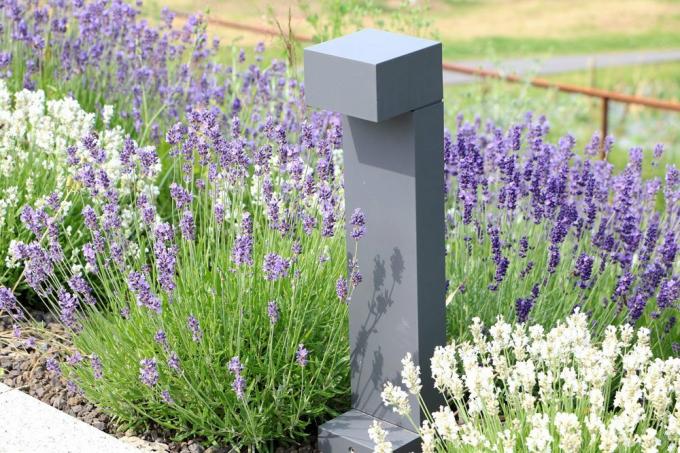
table of contents
- Hardy species
- wintering
- On the balcony
- In the pot
The lavender. The aroma and characteristic flowers are an essential component of any herb garden. The Mediterranean plant from the mint family (bot. Lamiaceae) was already used in the time of the Romans for the production of soaps and is not only kept in the garden today. Due to the robust growth, Lavandula species can easily be grown on the balcony if there is enough sun. But how does lavender overwinter when kept in a bucket or pot?
Hardy species
Which types of lavender are hardy?
Before describing winter protection, it is important to know which types of lavender are sensitive to frost or can easily cope with the domestic temperatures over the winter. This is important because this is the only way you can determine how effective the winter protection needs to be. Since lavender hibernates differently on the balcony than in the bed, the individual species must be compared with each other so that the wrong winter protection is not accidentally chosen. The types listed below are to be mentioned.
Real lavender (bot. Lavandula angustifolia)
Lavandula angustifolia is the classic type of lavender that can be grown and kept in Central Europe without any problems. This is an almost winter-hardy species that can withstand temperatures of -15 ° C and even withstand longer periods of frost with the right winter protection. In addition, this species is extremely robust and can easily be kept in the pot on the balcony. Wintering is the easiest with this taxon and there is no problem, especially in milder regions of Germany. Even snow-free winters with temperatures as low as -40 ° C can be survived as long as the location is right.

Woolly lavender (bot. Lavandula lanata)
Lavandula lanata is suitable for keeping over the winter, but in comparison to Lavandula angustifolia can only tolerate temperatures of down to -10 ° C over short periods. However, the "woolly" is very sensitive to frost when the temperature fluctuates around freezing point and therefore primarily needs a dry location so that it can survive the winter. Sufficient winter protection is required here.
Poppy lavender (bot. Lavandula stoechas)
The potted lavender, like Lavandula lanata, is quite sensitive to frost and can withstand temperatures as low as -10 ° C, but only for a short time. For this reason, it also needs winter protection with quite high temperatures so that it can get into the next year.
Broad-leaved lavender (bot. Lavandula latifolia)
Lavandula latifolia is also known as Speiklavender and can only withstand temperatures down to -5 ° C. Nevertheless, you can bring it safely through the winter if you choose the right winter protection.
Lavandin (bot. Lavandula × intermedia)
This hybrid is a popular cultivated form of Lavandula latifolia and Lavandula angustifolia. It can withstand frost better than the other species, but not as well as real lavender. It can overwinter at an average of -10 ° C, but lower temperatures are also possible if the location is outdoors.
Tip: Lavandula dentata, the French lavender, is not included in the above list because this species, like many other Lavandula species, is only grown as an annual plant in Germany can. The plant with its blue-violet flowers occurs only in warm areas of the western Mediterranean and is therefore not used to the local winter.

wintering
On the balcony
Of the above-mentioned species, only real lavender and lavandin are actually suitable for keeping in the tub on the balcony. If you want to safely overwinter the taxa, you can easily use your balcony with both species. Winter protection is essential here, as no moisture is drawn from the soil when kept in the bucket and the substrate can freeze quickly. Before wintering, the following points are important and you should definitely pay attention to them.
Planter
The bucket you choose can either add to the lavender or ideally bring the plant through the winter. The material is important when choosing the bucket. Terracotta pots have proven to be particularly effective, as they absorb excess moisture and store it in the material. This means that the substrate is not too wet over the winter. In addition, the planter must have drainage holes so that no water collects in the pot.
Location
The location must be well chosen, because too much sun can mean the end of the lavender.
Choose a location that looks like this:
- partially shaded
- sheltered from the wind
- if possible, free from snow
If you only have a south-facing balcony, you should set up sun protection. The closer the plant is to a house wall, the better.
cut
Do not cut the lavender too late in summer, otherwise the plant will not be able to produce enough plant material. The shoots serve as additional winter protection and, especially with real lavender, this is sufficient in most cases. In summer, prune Lavandula angustifolia as early as possible before it fades. If you live in a particularly cool region, you can even do without the cut.
With these precautions you can effectively help the plant through the winter. Now winter protection comes into play. The colder it is, the more important it is.

To do this, pack the planter as follows:
- take bubble wrap and cover the entire flower pot up to the edge
- Now a layer of jute material comes around the bubble wrap, which is fixed with a string
- alternatively, you can simply use a winter protection fleece for the two layers
- this is folded up to a height of 10 cm above the edge of the bucket
- Now wrap the planter with the fleece and fix it with a string
Now loosen the soil a little and pour carefully over the winter months so that the substrate does not dry out completely.
Tip: A popular way to get lavender through the winter is to keep it in bark mulch. To do this, simply place the planter in a wooden box and fill it completely with bark mulch. Of course, the plant has to look out of the filling. Bark mulch provides thermal insulation and even stores moisture and nutrients. This gives your lavender everything it needs over the winter.
In the pot
Overwintering in pots is suitable for all species, as the plants are not kept outdoors. This is particularly suitable for the woolly, broad-leaved and potted lavender who cannot withstand too long periods of frost and who want higher temperatures. Nevertheless, they can withstand long periods with little sun, as long as it doesn't get too cold for the herbs. These taxa can be brought through the winter in exactly the same way.
Please follow the following points:
- place the plants in the flower pot in a bright place
- the temperature should be between 5 ° C and 15 ° C
- Temperatures that are too high should be avoided, as otherwise the coppy lavender will dry out quickly
- Conservatories or unheated rooms are best for wintering
- even attics or storage rooms with enough light are suitable for this
- only water a little, as lavender is not a really thirsty plant
- however, the substrate should not dry out to avoid possible drying damage
- from February the herb should be carefully accustomed to warm temperatures again
- this means that you can easily transport the potted lavender outside at the end of winter
- Cut back from March, repot and loosen the soil as much as possible when repotting
- the roots can even be trimmed a bit
- the cut ensures vigorous budding in spring
- Pour on and enjoy the overwintered potted lavender

Alternatively, if you live in a warmer region with mild winters, you can overwinter the crested lavender as a balcony plant outdoors. For this, however, the plant must no longer be a young plant and must already have reached a corresponding size. In addition, the roots must be pronounced, otherwise the plant threatens to dry out. In addition, you have to keep the soil loose and the location has to be dry, because high humidity over the cold season leads to the death of the lavender. The flower pot is covered with brushwood and the plant is wrapped with fleece to defy the cold. Check the condition of the plant regularly.
